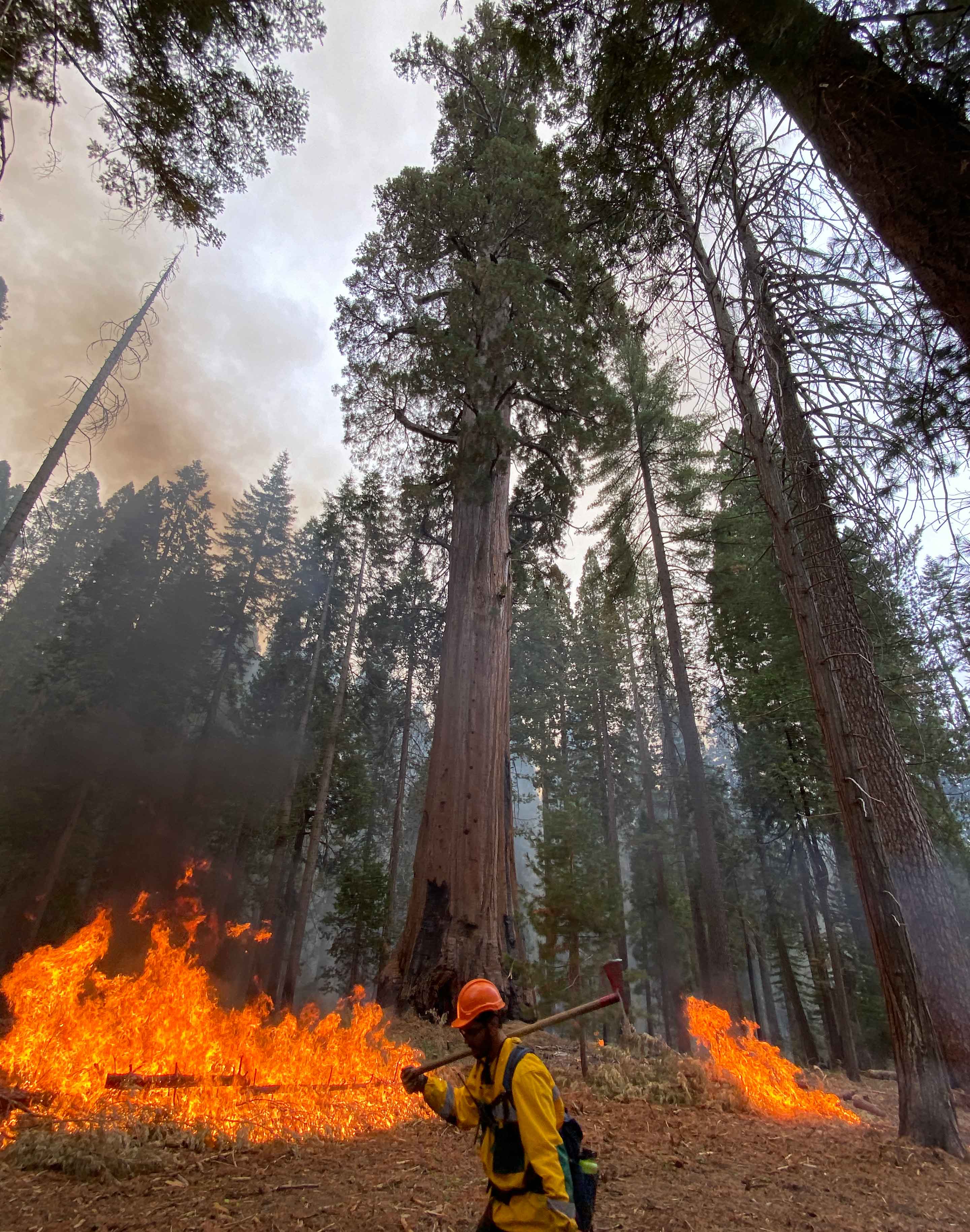Sunday, October 27, was a unique day for the Berkeley Forests researchers who manage Whitaker’s Forest, as they intentionally set fire at the site for the first time in over 50 years. The prescribed burn was carried out to advance research as well as to serve as a maintenance treatment following a 2021 wildfire in the area.

Drew Milan, a student at Reedley College, ignites "jackpots" of fuel around a large, old giant sequoia. The effects of the fire, as well as the preparation work done prior to the fire, are being studied to understand impacts to giant sequoia regeneration. Photo by Rob York.
Located adjacent to Kings Canyon National Park, Whitaker’s Forest has been managed by UC Berkeley for over a century. Research at the forest is focused on improving the understanding and management of giant sequoia forests. With some 10-14% of large sequoias in the world lost to wildfire since 2020, this work has become increasingly important.
With the need for permitting to be in place and weather conditions to be just right, the chance of conducting a prescribed burn after a hot, dry season but before winter rains can be extremely slim. But everything aligned late last month. “It was like the Hamilton musical,” said Rob York, co-director of Berkeley Forests, which manages Whitaker’s Forest. “We had one shot and we took it.”
The burn was led by York and Berkeley Forests staff, including Ariel Roughton and Aidan Sullivan, with assistance from undergraduate students Cooper Herrington, Alex Tucker, Cosette 'Cozy' Monson, Leigh Ambrose, and Lee Barr. Two CAL FIRE crews were also able to assist on site.
Prescribed fire hadn’t occurred at Whitaker’s forest since the 1960s when fire scientist Harold Biswell and his students conducted burns there and began researching and advocating for the use of prescribed burning for fire management. “Biswell’s work with prescribed fire at Whitaker's Forest was pioneering in getting people to understand the importance of using fire,” said York.
The KNP Complex fire burned through Whitaker’s Forest in 2021 and was one reason the Berkeley Forests team was focused on conducting a burn at the location this year. “That wildfire ‘broke the ice’ for fire in the forest, so we were interested in conducting what we call a maintenance burn, or second entry burn,” said York. “Continuing with a high frequency of fire mimics former conditions where there were frequent, low-intensity fires from lightning ignitions and Indigenous burning.”
Before the October 27th burn, the Berkeley Forests team and students from Reedley College prepared the forest using various treatments including the point protection method, which involves clearing various amounts of brush, shrubs, and other “fuel” from the forest floor, as well as leaving some areas untreated as a control. The researchers then studied how trees fared during the fire and the heat intensity up in the crowns of the giant trees. Going forward, they will continue to monitor the natural regeneration of the trees. “Giant Sequoias primarily release seeds during a fire, and they need enough heat to reach the upper heights of the trees to make that happen,” said York, who had previously worked with a team from Cornell University who climbed the giant trees to place sensors at the crowns.

Students Cooper Herrington and Leigh Ambrose douse a hot spot near the edge of the fire in order to make sure the fire is controlled. According to Berkeley Forests Co-director Rob York, prescribed fires that are managed to be low-intensity very rarely escape control. Of the very small fraction that do escape, only a small fraction of those actually cause damage to adjacent property. Photo courtesy of Berkeley Forests.
“Having the opportunity to take part in the burn allowed us to apply what we have learned in class and gave us the chance to hone our technical skills,” said Herrington, a third-year student majoring in Ecosystem Management and Forestry. “Being able to work with experienced and knowledgeable professionals like Rob helps us develop an eye for the relationship between fire behavior and post-fire effects, meaning the learning goes well beyond how to use a drip torch. On a grander scale, participating in the first UC-led prescribed fire at Whitaker's since Harold Biswell is such an honor and represents a big step in the reintroduction of this necessary ecological process."
After a full day of burning, York and his colleagues switched to patrolling and monitoring the area and will continue their research assessments at the site. “Fire is critical for the conservation of giant sequoia ecosystems, and restoring fire at a location with so much history in fire science was a career highlight for me,” said York. “Now, our great challenge as foresters is to try to apply the principles that Biswell and others discovered to make fire's presence on the landscape beneficial instead of detrimental."
If conditions allow, Berkeley Forests hopes to conduct additional burns at Blodgett Forest later this fall.
UC Berkeley has been a part of the Giant Sequoia Lands Coalition, a group working to steward the world’s giant sequoias, since 2021. Learn more about wildfire and forest management research at the Berkeley Forests website.
